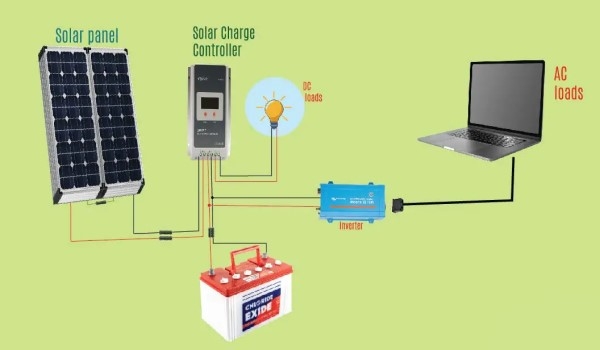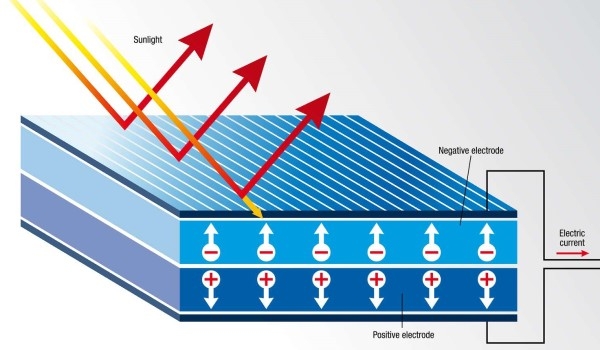Solar generator is a portable generator that uses sunlight as an energy source and can be used in a variety of scenarios. It is not dependent on the power grid, making it one of the most ideal props for off-grid living.
Main Components
A common solar powered generator consists of the following four parts:
- Solar panels: Solar panels are the central and most valuable part of a solar generation system. Their role is to convert the sun's radiant power into electricity, either to be sent to the battery for storage or to drive the load.
- Solar charge controller: The role of the solar charge controller is to control the working status of the whole solar powered generator system, and play a role in over-charging protection and over-discharge protection of the battery. In places with large temperature differences, qualified controllers should also have the function of temperature compensation. Other additional features such as light control switch, time control switch should be optional function.
- Inverter: The direct output of solar energy is generally 12 VDC, 24 VDC, 48 VDC. in order to be able to supply electrical energy to 220 VAC appliances, the DC energy emitted by the solar power system needs to be converted into AC energy, thus requiring the use of a DC-AC inverter.
- Battery: Lead-acid batteries are generally used, and nickel-metal hydride batteries, nickel-cadmium batteries or lithium batteries are also used in small micro systems. Its role is to store the electricity issued by the solar panel when there is light, and then release it when needed.

Working Principle
Solar generators use the photovoltaic effect to convert solar radiant energy directly into electrical energy. This process achieved through solar cells. Solar cell is a device that converts the sunlight energy directly into electrical energy due to the photovoltaic effect, a semiconductor photodiode, when the sun shines on the photodiode, it will turn the sunlight energy into electrical energy, generating an electric current. As the core component of a solar power station, a solar panel typically requires more than one solar cell. When many cells are connected in series or parallel, it can become a solar cell array with relatively large output power.
A blackbody (e.g. the sun) radiates electromagnetic waves of different wavelengths, such as infrared, ultraviolet, visible light, and so on. When these rays are irradiated on different conductors or semiconductors, photons interact with free electrons in the conductor or semiconductor to produce an electric current. The shorter the wavelength and the higher the frequency of the ray, the higher the energy it has, for example, ultraviolet rays have much higher energy than infrared rays. However, not all wavelengths of the energy of the ray can be converted into electrical energy, it is worth noting that the photovoltaic effect is not related to the intensity of the size of the ray, only the frequency of the photovoltaic effect can be generated when the frequency reaches or exceeds the threshold, the current can be generated. The maximum wavelength of the light that can make the semiconductor photovoltaic effect related to the width of the forbidden band, such as the the width of the forbidden band of crystalline silicon at room temperature is about 1.155eV, so must be wavelengths of less than 1100nm of light can make the crystalline silicon photovoltaic effect.
In more detail, photons from sunlight can excite the semiconductor material in the solar cell so that electrons are excited from the valence band of the atom into the conduction band, forming electron-hole pairs. Under the action of the p-n junction, holes flow from the n-type region to the p-type region and electrons flow from the p-type region to the n-type region. This creates a potential difference between the two ends of the solar cell, which generates an electric current. After a solar generator creates electricity, it also needs to store and utilize it.

The DC power generated by the solar cells is first stored in a battery, which affects the efficiency and characteristics of the system. Battery technology is very mature, but its capacity is affected by the amount of power required, the sunshine time (power generation time). Therefore, the watt-hour capacity and ampere-hour capacity of the battery are determined by a predetermined period of continuous sunless time. When the battery is working, the solar charge controller specifies and controls its charging and discharging conditions. When the battery voltage rises to a certain level, the controller can stop the charging of the battery.
Finally, through DC conversion, the solar generator converts the DC output from the solar cell into AC power for daily use. This process achieved through an inverter. The inverter consists of an inverter bridge, control logic and filter circuit.
Generally speaking, the working process of a solar energy generator can be briefly summarized as follows:
- Sunlight irradiates on the solar panels.
- Panels convert it into electrical energy and output it.
- Inverter converts the direct current (DC) into alternating current (AC) for use by the equipment,.
- Remaining energy is stored in the battery.
After learning how solar generators work, I believe you have a new understanding of how to properly use them. As the most core component of solar generation system, the quality of solar panels directly affects the lifespan and power generation efficiency of the whole system. PowerHome online shop can provide you with high quality solar panels to ensure that your solar generator can run efficiently at any time. Not only that, reasonable layout and installation, regular maintenance and monitoring of the system, formulation of effective energy management strategies, and attention to environmental protection and sustainable development issues are all key factors in ensuring stable operation of the solar generation system and improving power generation efficiency.
(1).png)
(1).png)